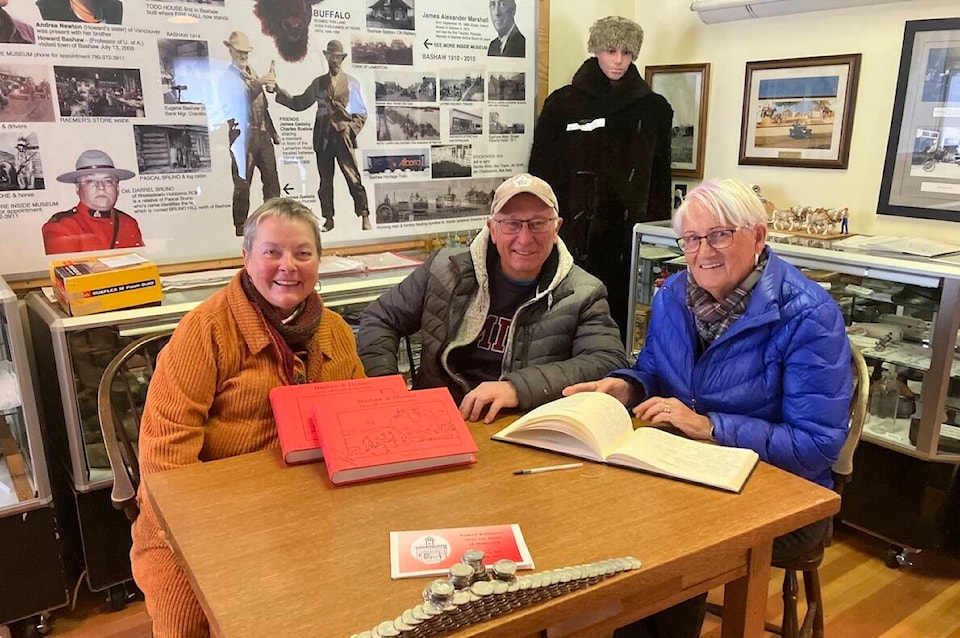With the goal of chronicling and preserving local history, the Bashaw Fire Hall Museum showcases many aspects of the Central Alberta town’s past.
“Our history is why we are who we are,” says Terri Brown-Gust, a member of the Bashaw Historical Society. “And we want to spread that knowledge.”
By regularly changing the displays, the museum showcases different artifacts and chapters of the community’s history.
The building itself has quite a storied history.
According to the town’s website, in the early years, village council meetings were held there.
“The village constable had a small living quarter in the back of the building and kept the building heated. One room served as a provincial courthouse. One of the cells was used as a dog pound, with the door still showing the evidence of a dog attempting to chew his way out.”
At one time, police officers worked out of the building, and the public library was also set up here for several years, along with a barbershop.
As Val Wandler, another society member points out, it’s this history that also makes the museum — which is packed with all sorts of artifacts from Bashaw’s various eras — a special place.
And it matters to local residents who wish to ensure their donated items are kept in a safe environment.
“It’s nice to have somewhere to put some of the things that people bring us,” she says. “It means something. We take it, and the donors feel good because it’s gone somewhere where it can be preserved.”
Society member Bryan Gust agrees.
“It’s a place for people to bring their histories,” he says. “It’s really a collection place.”
According to historicplaces.ca, “Notable inside features run the gamut from the two jail cells (one with a steel door and one with a heavy wooden door) and original lighting fixtures to the fire-resistant concrete storage vault with a steel door and a 37,000 gallon, poured-in-place concrete water storage tank under the floor.”
Histories of the community are also available for purchase (a two-volume set).
And speaking of those aforementioned jail cells, one has a particular claim to fame.
Notorious criminal Robert Raymond Cook was held in this cell after being apprehended by police on a farm close to town. About 400 people gathered to watch the bedraggled escapee escorted into the building.
The horrific Cook case rocked the region in June of 1959 when Raymond and Daisy Cook and their five children were found shot and bludgeoned to death in the garage of their Stettler home.
Robert, 21 at the time, was convicted of the crimes in the Old Red Deer Court House. He was retried later in Edmonton and again found guilty, and was executed by hanging in November 1960.
Cook insisted he was innocent right up until the end.
The cell Cook was held in at the Bashaw museum has numerous articles posted on the walls about the case, several photos, plus a mannequin posed in the corner where Cook stood for police photos. The room has scarcely changed, Bryan says.
The museum sells a DVD that chronicles the case, plus several years ago a play called At the End of the Rope was staged at the Majestic Theatre. The play chronicles the experiences of Cook and his lawyer Dave MacNaughton during their 18-month battle to evade the noose.
Questions linger as to Cook’s guilt, which is likely why the case has such staying power.
His alibi of being in Edmonton during the night of the murders couldn’t be cracked, although pinpointing the times of the deaths wasn’t as advanced as it is today.
In a letter to his lawyer, Cook wrote he “used to think it was up to the Crown to prove a person guilty, now, I believe different. I know they cannot prove me guilty, for in all truth, I am not. If I hang, murder will be committed in the name of the law.”
Val Wandler, another member of the Bashaw Historical Society, says the play at the Majestic certainly spurred interest in the case.
“Lots of people still question whether he did it or not, so that still comes up,” she says.
“When we had the play at the theatre, with some of the first people who came in, we asked if they wanted to be on a jury. They got to sit up front and watch the show, and then at the end of the night, they would decide whether they thought he was guilty or not.
“I think it was quite mixed.”
Meanwhile, society members would like to broaden the educational reach of the organization as well, perhaps by installing QR codes so that people can conveniently tap into the histories and stories of certain places around town.
“There is also an old firetruck by the arena,” Wandler says, pointing to just one example. “We would like to be able to have a QR code on there so people can scan that.”
If you go:
- The Bashaw Fire Hall Museum is open Wednesday to Saturday from 10 a.m. to 4 p.m. during the summer months at 5018 5o St., Bashaw, Alta.
- Learn more at townofbashaw.com.
